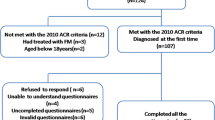Abstract
Objectives
To assess the clinical features and functional and psychological status of patients with rheumatoid arthritis (RA) and those with fibromyalgia (FM) in a real-world setting.
Method
Between December 2018 and April 2019, 202 inpatients with RA were enrolled from the Rheumatology and Immunology Department at Peking University People’s Hospital and assessed for the presence of FM using the 1990 American College of Rheumatology’s classification criteria for FM. Disease activity and functional and psychological status were assessed using the Disease Activity Score in 28 joints (DAS-28), Short-Form 36 (SF-36), Health Assessment Questionnaire (HAQ), Hospital Anxiety and Depression Scale, and Visual Analog Scale.
Results
Among the patients with RA, 42 (20.8%) had concurrent FM. Compared with patients without FM, patients with FM had higher DAS-28 (6.0 vs. 4.4, P = 0.011) and notably higher tender joint counts (16.5 vs. 4.5, P < 0.001). Patients with RA and FM had worse HAQ scores (1.24 vs. 0.66, P < 0.001) and lower SF-36 scores (28.6 vs. 58.2, P < 0.001). Patients with RA and FM experienced more fatigue (88.1% vs. 50.6%, P < 0.001) and had higher anxiety (10 vs. 4, P < 0.001) and depression scores (12 vs. 6, P < 0.001). No significant differences in erythrocyte sedimentation rate, C-reactive protein concentration, morning stiffness period, or swollen joint counts were found between the groups.
Conclusions
Patients with RA and FM had higher disease activity, a worse functional and psychological status, and poorer quality of life. The DAS-28 may have been overestimated in these patients. When patients with RA do not reach remission, FM should be considered.
Key Points • Patients with rheumatoid arthritis and fibromyalgia had a worse functional and psychological status compared with those with rheumatoid arthritis alone. • When patients with rheumatoid arthritis do not reach remission, fibromyalgia should be considered. • Physicians should avoid overtreatment and enable these patients to receive the treatment, such as non-drug interventions, that they need. |
Similar content being viewed by others
Data availability
The datasets generated during and/or analyzed during the current study are available from the corresponding author on reasonable request.
References
Abbasi L, Haidri FR (2014) Fibromyalgia complicating disease management in rheumatoid arthritis. J Coll Physicians Surg Pak 24:424–427
Clauw DJ (2014) Fibromyalgia: a clinical review. JAMA 311:1547–1555
Wolfe F, Ross K, Anderson J, Russell IJ, Hebert L (1995) The prevalence and characteristics of fibromyalgia in the general population. Arthritis Rheum 38:19–28
Wolfe F, Clauw DJ, Fitzcharles MA et al (2011) Fibromyalgia criteria and severity scales for clinical and epidemiological studies: a modification of the ACR Preliminary Diagnostic Criteria for Fibromyalgia. J Rheumatol 38:1113–1122
Wolfe F, Häuser W, Hassett AL, Katz RS, Walitt BT (2011) The development of fibromyalgia: examination of rates and predictors in patients with rheumatoid arthritis (RA). Pain 152:291–299
Vincent A, Lahr BD, Wolfe F et al (2013) Prevalence of fibromyalgia: a population-based study in Olmsted County, Minnesota, utilizing the Rochester Epidemiology Project. Arthritis Care Res (Hoboken) 65:786–792
Joharatnam N, Mcwilliams DF, Wilson D, Wheeler M, Pande I, Walsh DA (2015) A cross-sectional study of pain sensitivity, disease-activity assessment, mental health, and fibromyalgia status in rheumatoid arthritis. Arthritis Res Ther 17:11
Kiliçarslan A, Yurdakul FG, Bodur H (2018) Diagnosing fibromyalgia in rheumatoid arthritis: the importance of assessing disease activity. Turk J Phys Med Rehab 64:133–139
Ulus Y, Akyol Y, Tander B, Durmus D, Bilgici A, Kuru O (2011) Sleep quality in fibromyalgia and rheumatoid arthritis: associations with pain, fatigue, depression, and disease activity. Clin Exp Rheumatol 29(6 Suppl 69):S92–S96
Wolfe F, Michaud K (2004) Severe rheumatoid arthritis (RA), worse outcomes, comorbid illness, and sociodemographic disadvantage characterize RA patients with fibromyalgia. J Rheumatol 31:695–700
Pollard LC, Kingsley GH, Choy EH, Scott DL (2010) Fibromyalgic rheumatoid arthritis and disease assessment. Rheumatology (Oxford) 49:924–928
Wolfe F, Smythe HA, Yunus MB et al (1990) The American College of Rheumatology 1990 criteria for the classification of fibromyalgia. Report of the Multicenter Criteria Committee. Arthritis Rheum 33:160–172
Mu R, Li C, Zhu JX et al (2013) National survey of knowledge, attitude and practice of fibromyalgia among rheumatologists in China. Int J Rheum Dis 16:258–263
Queiroz LP (2013) Worldwide epidemiology of fibromyalgia. Curr Pain Headache Rep 17:356
Gist AC, Guymer EK, Eades LE, Leech M, Littlejohn GO (2018) Fibromyalgia remains a significant burden in rheumatoid arthritis in Australia. Int J Rheum Dis 21:639–646
Kim H, Cui J, Frits M et al (2017) Fibromyalgia predicts two-year changes in functional status in rheumatoid arthritis patients. Arthritis Care Res (Hoboken) 69:1871–1877
Macfarlane GJ, Kronisch C, Dean LE et al (2017) EULAR revised recommendations for the management of fibromyalgia. Ann Rheum Dis 76:318–328
Acknowledgements
We would like to thank Editage (www.editage.cn) for English language editing.
Author information
Authors and Affiliations
Contributions
CG conducted most of the experiments. LC and TL conceived the study and design it. HZ drafted the manuscript and participated in data analysis. LW, HY, XH, and YJ helped to collect data. TL and CL participated in interpretation of results and reviewed the manuscript. All authors approved the final version to be submitted for publication.
This study was supported by funds from the National Natural Science Foundation of China (81671609), the Beijing Science and Technology Planning Project (Z191100006619111), the Beijing Municipal Natural Science Foundation (7192211), and the Peking University People’s Hospital Research and Development Found (RDN2019-02).
Corresponding authors
Ethics declarations
Disclosures
None.
Additional information
Publisher's note
Springer Nature remains neutral with regard to jurisdictional claims in published maps and institutional affiliations.
The authors’ equal contribution has been added.
Chao Gao and Hua Zhong are shared first authors.
Rights and permissions
About this article
Cite this article
Gao, C., Zhong, H., Chen, L. et al. Clinical and psychological assessment of patients with rheumatoid arthritis and fibromyalgia: a real-world study. Clin Rheumatol 41, 1235–1240 (2022). https://doi.org/10.1007/s10067-021-06026-6
Received:
Revised:
Accepted:
Published:
Issue Date:
DOI: https://doi.org/10.1007/s10067-021-06026-6




